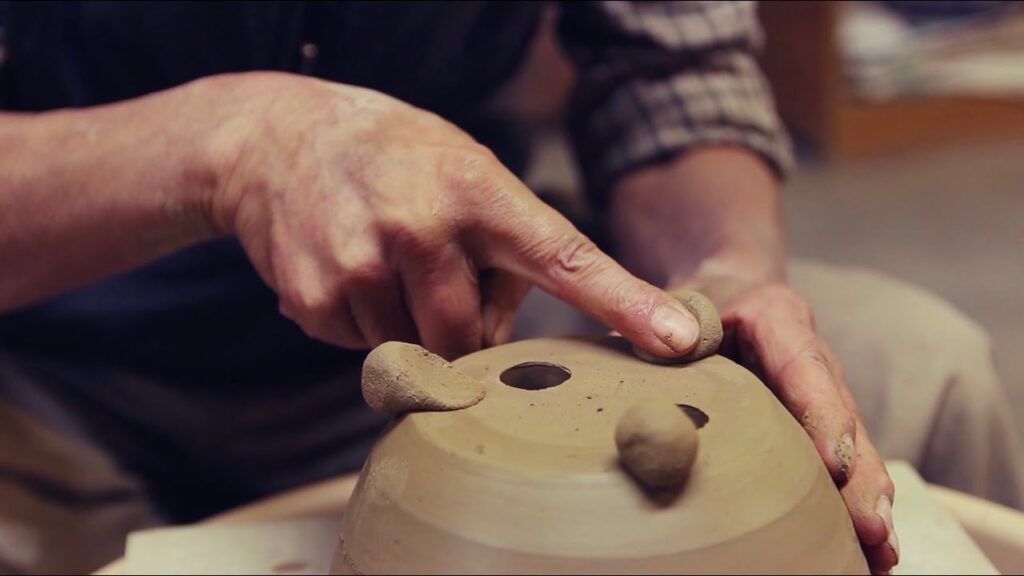Meet the Clay Masters of Tokoname in this mini-documentary on Bonsai ceramics!
Tokoname is one of the six famous old kilns of Japan, producing tea pots, sewer pipes and… Bonsai Pots. Though Tokoname was famous for its clay (Tokoname literally means "Always smooth"), much of that has ran out and what remains are highly skilled craftsman, with a reputation for quality Bonsai containers, both glazed and unglazed.
Invited by the Tokoname association, we shot this documentary on the true craftsmanship of the potters. Focusing on the process of creating a Bonsai pot, we filmed six artists in their ateliers.
The stars of the film:
Tatsuhiro Tanaka (Clay Atelier)
Katsushi Kataoka (Reiho, Seizan Toen)
Kazuhiro Watanabe (Ikko, Kanesho Seitosho)
Kakuyuki Watanabe (Kakuzan toen)
Katsuichi Shibata (Shibakatsu en)
Hidemi Kataoka (Shuuhou, Yoshimura toen)
And the process of creating Bonsai pots:
Step 1: Preparing the clay
At the Atelier of Tokoname clay they import, mix, purify and distribute all the clay for the all potters in Tokoname. For different types of pottery, there are different types of clay and the potters can customize their own mixture for the best characteristics.
Once the clay is at the potter, it will be kneaded by both hand and machine to enable the potter to work with it. Normally a potter uses a machine to make the clay more soft and then knead it in the right shape.
Next, there are three different ways to shape a pot. We'll explain the shaping with a mould first and after that describe how the wheel and manual methods work.
Step 2a: Shaping with a mould
The slab of clay is created by kneading the clay thoroughly and then creating thin layers by running a thin steel wire across the clay.
The slab is then rolled onto a pipe to transport it to the mould.
Finally, the slab is then pushed and shaped into the mould using a sand bag. Excess clay on the inside is now removed using a spatula, to make sure the thickness of the clay is uniform. The moulded pot then needs to dry for a day, before the mould can be removed. Usually this is the moment to add the stamp on the bottom of the pot, as well as creating holes for drainage. Finally, with some moulds the rim also needs to be added manually.
Step 2b: Shaping with a wheel
Using the wheel is probably the method that we always think of when talking about pottery. The potters show incredible craftsmanship when creating the perfect shape for the bonsai pot.
While the feet of the pot are automatically created when using a mould, the potter that uses the wheel as a shaping method, needs to create this separately (usually after one day of drying first).
Step 2c: Shaping with clay slabs
Not all pots can be made using moulds or wheels. As not all can be similar in shape and not all are round. Some potters rather form the bonsai pots themselves using slabs that they cut out themselves. This enables them to make one of a kind pots that are exactly designed to their customer’s wishes. Usually the body of the pot is designed first and after a few hours drying the rim is added, and again a few hours later the feet can be created.
Step 3: Finishing and drying
Water finishing. To smoothen the surface and edges of the pot, the craftsmen use all kinds of cloths and cards that they dip in water.
Drying. Drying makes sure that the pots stay in the right shape when being fired later. Drying can take between 1-3 days time depending on the size of the pot. On this photo several glazed pots are drying, almost ready to be fired.
Step 4: Glazing
Some pots are glazed, mostly to suit Deciduous or broadleaf evergreen trees. The pot is dipped into a basin of glaze, after which it is left to dry for about a day before being fired. Sometimes a second glazing is added and the pot would be fired again.
Step 5: Finishing and firing
Both the surface and the edges are polished and smoothened during the drying process, right before the firing.
After one day of drying the potter can add their own brand mark by either scribbling or pressing their name on the bottom of the pot.
The kiln is then packed with pots and over the course of about 30 hours heated to 1180 degrees Celsius, and cooled down again.
This film is a cooperation of Bonsai Empire with the Japan Patent Office (JPO) and the Japan External Trade Organization (JETRO).
Music, in order of playing: Chat roulette, Avert your Eyes, Water Lillies, 1.42, Still (Hiatus), Mana Two, Lullaby, Sixteen Twenty Five.
More information:


Fantastic, I cannot imagine the amount of dedication and time that went into making this video for us!
Thanks Nigel! It was quite a big undertaking 🙂
We really love to hear your opinion on this film! Should we do more? On what topics? Let us know!
Oh yes , definitely it’s like a meditation for me. Thanks
I’d love a documentary on Sandai Shogun No Matsu, haven’t found an English one. Of course, access iś not easy 🙂
Yup, thank you! this is amazingly great, loving the authenticity. As the people before me said, a movie on the production of bonsai tools, one on traditional Japanese Bonsai soil harvesting, one on seed harvesting and propagation(cinematic, filmed with macro shots, time lapses, and a few different species, evergreens and deciduous too), one on the importance of trees, forests and conscious and responsible Yamadori practice. Other than that, please keep doing it.
Loved this but no need for the backing music which distracted
This was absolutely amazing. I just recently got into bonsai but have been into clay and pottery since I was 16. I have been wanting to know how to make my own bonsai pots and this film gave me more insight than I found anywhere else! And it was so interesting and beautiful ❤️
Thank you so much for the time and dedication that went into making this video! I am a potter myself and I absolutely loved it!!
Thanks!
WOW!!!! . . . Such an amazing and very interesting video.
Each and every bonsai video I watch just makes my heart grow fonder.
I’ve been dedicated to bonsai for many years, yet I’ve still so much to learn.
Very educational film on the work – and craftsmanship – that goes in to making Bonsai pots. I will no longer look at my ‘pots’ as *just* pots. Thank you for such an informative film.
I’m returning to give time to the Bonsai I’ve had a number of years but had to plant in to containers due to other life commitments, just happened across your film and have now subscribed.
Thanks Frank, really appreciate your comment and glad it was educational!
It is perfect. Thanks for bringing this to us. It is pretty much fascinating to see the people of Japan being devoted to their works with such a dedication 🙏
Oscar, I really loved this video. One can really see the artistry, the craftmanship, love and respect you put in this video. Yes please! More of this kind of videos! Your other videos are beautifull and I always look forward to see them but whit this you reached another level! Thank you. Regards from Sweden.
Thanks a lot Claudio!
I love hearing the stories of Japanese artisans who are the descendants of Japanese artisans. In a world that’s always changing, it’s comforting to know that there are still people practicing and preserving ancestral knowledge from generations past.
Excellent documentary! Realy good work quys and thanks for this video. I’m simply fascinated about masters respect for the clay for the whole process of making the pot and their techniques. More vids like that guys.
Thank you for that fantastic documentary!
Makes me understand why some pots are more expensive. After watching we should all know, that these are worth it.
I love the passion! 🙂
wow!! really amazing to see these artists at work! love how you showed us the different styles! keep up with the great work!
I really love when a video is produced with such charm and is also educational and insightful.
Please do more of this awesome content, it is literally a grounding experience.
I loved this video. The Clay Masters are wonderful and I enjoyed listening to them explain their process. I’m amazed at the time you spent in your explanation. You clearly have a love of this subject and much respect for the Clay Masters. Thank you.
beautiful documentary!!! i’d love to see more content like this.
i’m also very intrigued by how this art was passed down through fathers. i wonder if these men were able to pass their skills down to their children? also curious about daughters. 🙂
This is absolutely beautiful! Thank you so much for putting the time and effort into making this video!
Awesome video. I love seeing the kind of amazing craftsmanship that goes into something like making pottery. I had no idea how involved the process was.
I love that All these people were Masters in their Craft, 35 40 years do what they do, they made it look so easy, even though it took so many years to perfect, beautiful bonsai pottery each one, I especially like the footings
Amazing. I watched it twice in a row. It is so relaxing watching them creating such masterpieces. So inspirational.
Thank you so much 😀
@Bonsai Empire do you know if there is any book about Tokoname pot tradition and history you reccomend? Thanks!
Fantástico lindo trabalho